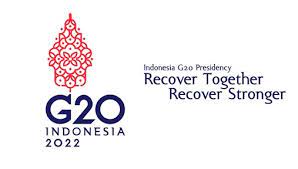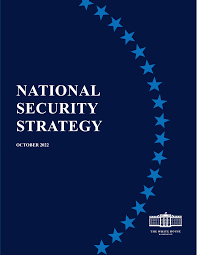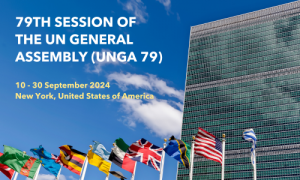
Well, the UN ‘Summit of the Future’ (SoTF) has come – and gone. What does the appearance and passing of the SoTF, and the continuation of the UN General Assembly’s High-level Week tell us about the state of the UN and the condition of global multilateralism? If I may be so bold it is – “not good!” But there may be a thread or two that might lead to more effective multilateralism. Still I suspect after the most recent Posts this immediate conclusion can hardly be a surprise. Reflecting on the UN proceeding, Bloomberg reported:
The United Nations General Assembly’s annual meeting in New York is often mocked as a farce for the endless speeches and the traffic snarling the city. This year’s gathering feels more like tragedy.
The violence and chaos engulfing the globe put questions around the UN mandate — “save succeeding generations from the scourge of war” — in stark relief.
Antonio Guterres is the first to admit that the secretary-general of the UN has no power, just a voice (emphasis added). It’s one he uses time and time again like a modern-day Cassandra to lament that the world is currently experiencing the most conflicts since the organization was founded in 1945. The past three years were the most violent in three decades, according to one think tank.
So the international context is not good. But looking specifically at the SoTF, let’s look at the result. On the positive side the UN passed, ultimately unanimously the ‘Pact for the Future’. Why I say ultimately is because the document’s final passage suffered from great power intrigue before the Pact of the Future was agreed to and passage concluded. As pointed out by IISD, the International Institute for Sustainable Development:
The Summit of the Future opened with some drama when the Russian Federation tabled its objection to several paragraphs in the outcome documents: the Pact for the Future, the Global Digital Compact, and Declaration on Future Generations
Russia’s Deputy Foreign Minister Sergey Vershinin tabled Russian objections and, according to AlJazeera:
Vershinin also stressed that the pact could not be viewed as creating “new mandates and obligations” for states as it is “simply a declaration, and a very vague one.
In the face of these objections, interestingly, the Republic of Congo – representing Africa’s 54 nations – and Mexico, rejected the Russian amendments and preventing them from going through. With the loud opposition from members of the Global South to Russia’s objections, the IISD reported:
… after months of negotiations, the Pact was adopted. UN General Assembly (UNGA) President Philémon Yang thanked the Co-Facilitators for steering a complex negotiating process and described the just-adopted Pact as a reflection of “our pledge” to lay the foundation for a sustainable, inclusive, and peaceful global order.
On the positive side, the final Pact appears to retain the Security Council reform initiative. Though the Action numbers have changed, it appears that the reform provision has been retained:
Action 40. We will strengthen our efforts in the framework of the intergovernmental negotiations on Security Council reform as a matter of priority and without delay …
Encourage the submission of further models and the revision of already presented models by States and Groups of States for the structured dialogues with a view to developing a consolidated model in the future based on convergences on the five clusters, and the models presented by Member States.
It is there but we wait to see results. There appears to many at the UN to be a greater ‘majority’ to reform the Security Council, and how it works. Such reform seems to include a growing consensus to permanently add members to the Security Council. For some time now the US has lead the charge to include India, Germany , Brazil and Japan, though without a veto, and Ambassador Thomas-Greeleaf announced a US position urging two permanent seats for developing country members and a spot for a SIDS (Small Island Developing States) seat. Yet final agreement appears to be out of the reach for the members.
Now, interestingly there were a variety of insights provided by Richard Gown, currently the UN Director for the International Crisis Group, who was interviewed on the 25th by Ravi Agrawal, editor in chief of Foreign Policy. In this FP: Live session titled: “Can the United Nations Still be Effective?”, Gowan, who has long been involved with the UN, suggested that what was most interesting in the Pact was not Security Council reform but the effort to focus on digital governance and the initiation of negotiations on AI in the Digital Compact, Annex I: Global Digital Compact:
“Objective 5. Enhance international governance of artificial intelligence for the benefit of humanity”
56. We therefore commit to:
(a) Establish, within the United Nations, a multidisciplinary Independent International Scientific Panel on AI with balanced geographic representation to promote scientific understanding through evidence-based impact, risk and opportunity assessments, drawing on existing national, regional and international initiatives and research networks (SDG 17);
(b) Initiate, within the United Nations, a Global Dialogue on AI Governance involving Governments and all relevant stakeholders which will take place in the margins of existing relevant United Nations conferences and meetings (SDG 17).
Gowan suggested in the interview that the effort here with AI might well bear fruit in years to come with rules on digital governance and AI. It will in his view be looked at retrospectively as the Pact for the Future provided the framework for critical digital governance success.
Gowan was also clear-eyed when it came to the UN and its capacity to constrain and resolve conflict. He was blunt that what he called ‘first order’ crises – Ukraine and Gaza currently, due to great power rivalries and political actions are currently out of the reach of the UN to achieve any level of success and ultimately political resolution. On the other hand, what he described as ‘second order’ conflicts – an example Sudan, where most great power rivalries are not at play, can be subject to UN collective peace efforts.
So it is evident that many of the conflict crises are outside effective UN efforts. Still, Gowan reminded us that ‘everyday multilateralism’ is at the heart of today’s UN efforts. While the UN today cannot end wars, it is critical in providing significant action and progress in mitigating the consequences of violence, pandemics, and natural and climate disasters. UN agencies may be the only major players in these circumstances.
Finally, Gowan pointed out where attention needed to be paid to these recent UN summit efforts. The declarations and pacts could be largely ignored; the statements and speeches by Heads of Government and State could equally be set aside and forgotten but the actual gathering of leaders could enable numerous bilateral and minilateral meetings at the margin of the formal meetings. These highly informal discussions could be settings where positions could be staked out and possible positive steps could be agreed by leaders that later translated into real progress. It might be ‘small ball’ but it could ultimately lead to progress. The informality is evident and such in-person gatherings could easily be missed but quietly and ‘below the radar’ such quiet conversations could provide real opportunity to resolve the all too difficult and seemingly intractable moments of violence. This is informal, very informal ‘multilateralism’. But progress may be possible.
Image Credit: IFPRI (International Food Policy Research Institute)
This Post first appeared at my Substack Alan’s Newsletter
https://open.substack.com/pub/globalsummitryproject/p/once-in-a-generation-well-maybe-not?r=bj&utm_campaign=post&utm_medium=web&showWelcomeOnShare=true


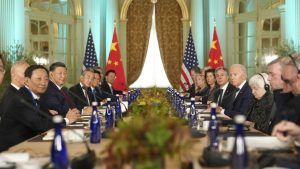 My colleague, Michael Swaine, now a Senior Research Fellow at the Quincy Institute for Responsible Statecraft, has produced two very insightful pieces on US-China relations. The longer piece can be found as a
My colleague, Michael Swaine, now a Senior Research Fellow at the Quincy Institute for Responsible Statecraft, has produced two very insightful pieces on US-China relations. The longer piece can be found as a 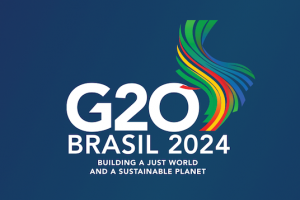

 We are definitely in the midst of Global Summitry gatherings. With the BRICS Summit just recently ended, we are deep into the G20 weekend gathering in New Delhi. So much commentary has accompanied these summitry gatherings. But I caution casual observers and readers: there are way too many assessments and conclusions drawn by all those folks that unfortunately barely pay attention to Global Summitry through much of the year. You can see this in the various ‘hair on fire’ commentaries in the assessments and consequences of the actions of key players in both the BRICS and now especially with the G20. Too many declarations of the G20 demise; firm conclusions that China and Russia would block any consensus statement that sought to condemn Russia’s aggression against Ukraine; the fragmentation of global summitry with the rise of the BRICS plus and the demise of the G20 with leaders from Russia and China choosing to absent themselves from summit.
We are definitely in the midst of Global Summitry gatherings. With the BRICS Summit just recently ended, we are deep into the G20 weekend gathering in New Delhi. So much commentary has accompanied these summitry gatherings. But I caution casual observers and readers: there are way too many assessments and conclusions drawn by all those folks that unfortunately barely pay attention to Global Summitry through much of the year. You can see this in the various ‘hair on fire’ commentaries in the assessments and consequences of the actions of key players in both the BRICS and now especially with the G20. Too many declarations of the G20 demise; firm conclusions that China and Russia would block any consensus statement that sought to condemn Russia’s aggression against Ukraine; the fragmentation of global summitry with the rise of the BRICS plus and the demise of the G20 with leaders from Russia and China choosing to absent themselves from summit.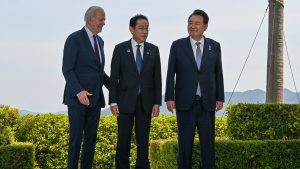
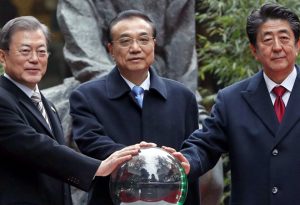 While I have suggested earlier that I don’t think an initial focus on building regional or multilateral institutions is necessarily the best first step in global governance and possibly a means to ‘tone down’ geopolitical competition rhetoric and action, I am now about to contradict myself and this position. For, in the end, there are some obvious regional and international institutions that could encourage collaborative action and push global governance collaboration. And, in fact, I have in mind an obvious one that has – as a current Chinese slang term might well describe it – ‘tang ping’ 躺平 – or ‘lying flat’. It is the Trilateral Summit.
While I have suggested earlier that I don’t think an initial focus on building regional or multilateral institutions is necessarily the best first step in global governance and possibly a means to ‘tone down’ geopolitical competition rhetoric and action, I am now about to contradict myself and this position. For, in the end, there are some obvious regional and international institutions that could encourage collaborative action and push global governance collaboration. And, in fact, I have in mind an obvious one that has – as a current Chinese slang term might well describe it – ‘tang ping’ 躺平 – or ‘lying flat’. It is the Trilateral Summit.